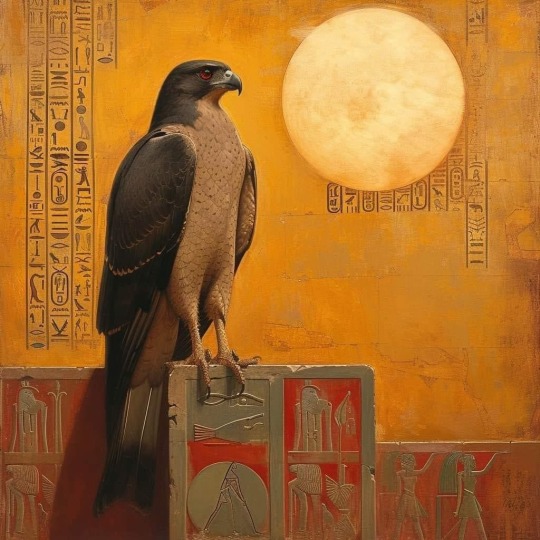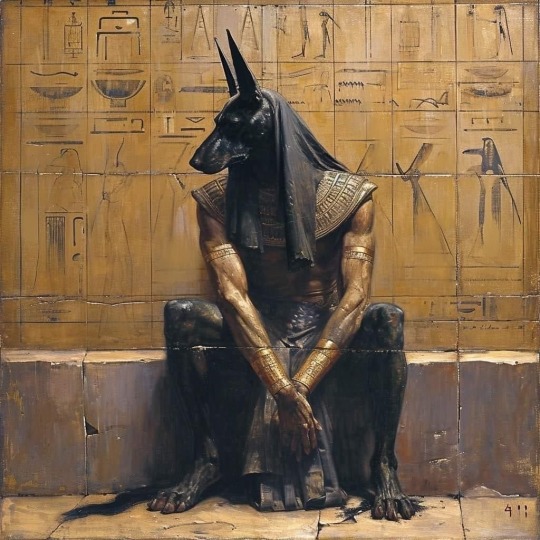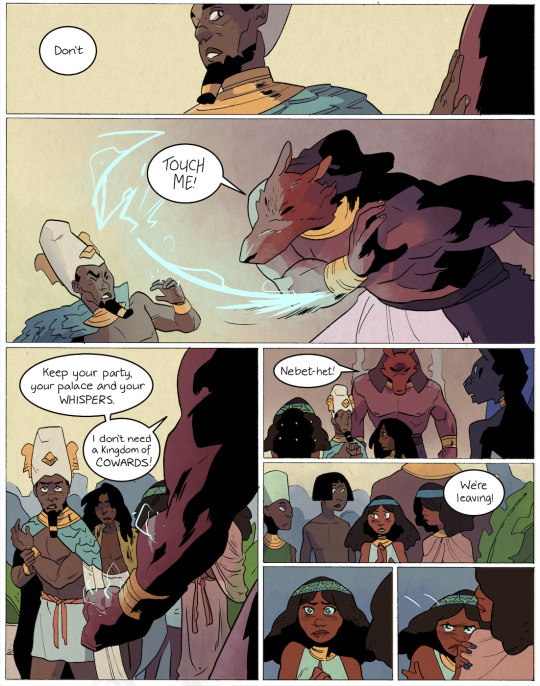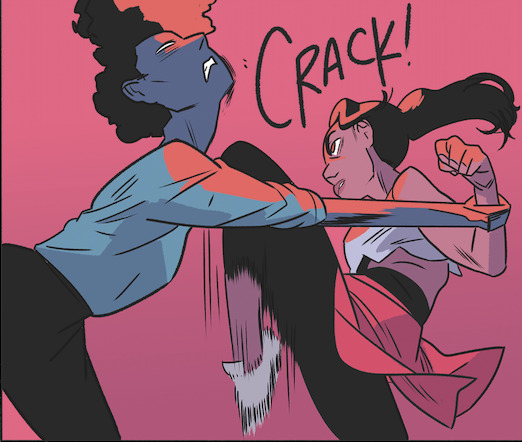#Egyptian deities
Text
am i the only one who thinks about the fact gods are in their home? like, what do you mean gods visit me? they look at my room, my bed, my clothes, the mess that i make on my couch with all my plushies and clothes, random bras and socks that i didn’t like thrown around…and my parent’s bedroom and all their shiny jewels and cute sculptures, the living room and its coziness, the kitchen and its persistent smell of homecooked food? do they like it? what do they think? in the end, it’s just like when a important person visits you. you can’t do anything but hope it is cosy for them.
#paganism#paganblr#pagan witch#witchcraft#witchblr#deity work#deity worship#greek deities#helpol#egyptian deities#kemetic#norse paganism#norse gods#norse mythology
31 notes
·
View notes
Text

Fritz Schwimbeck (1889-1972) - Totengericht (Judgment of the Dead)
493 notes
·
View notes
Text
Pagan syncretism is the best. I love being able to worship whomever, whenever. I love being able to study occultism from around the world and put together a practice that is so unique and special to me. I love being able to worship gods from ancient societies like Greece. I love the even more ancient gods from Egypt. And we can go back further and revive the gods from Sumer! I love honoring spirits of the sun, and moon, of death, and love. I love being playful with the faeries, soaring with dragons, and meditating with bodhisattvas. If it is open to me, I am willing to learn and boy has it enriched my life tenfold! I don’t ever want to stop!
#pagan#paganism#hellenic deities#hellenic devotion#polytheism#omnism#animism#syncretism#dragons#faeries#faery witch#faerie#fae folk#bodhisattva#meditation#mesopotamian deities#kemetic#egyptian deities#greek gods#shinto#buddah
269 notes
·
View notes
Text






Ancient Egyptian Deities
273 notes
·
View notes
Text





I'm Very Normal about Set as a character.
⚡️GODSLAVE⚡️ is an action/urban fantasy story, featuring a girl's journey into Egyptian mythology in the modern day.
Live on kickstarter!
#egyptian gods#egyptian mythology#set#setesh#Osiris#nebethet#nephthys#mythology#deities#Egyptian deities#egyptology#webcomic#webcomics#comic#comics
544 notes
·
View notes
Text
ʚ Reminder ɞ
It's ok if you can't afford fancy offerings to deities.
It's ok if you don't work with or worship deities.
It's ok if your altar is small.
It's ok if your altar was made from things found at a dollar store.
It's ok if you don't have an altar.
It's ok if you don't read tarot cards, or do pendulum.
It's ok if you can't read Oracle cards.
It's ok if you only wanna work with the stars and moon.
It's ok of you only wanna do simple candle spells.
It's ok to only focus on one craft.
Your craft is YOUR CRAFT. You do what feels right to you always. Don't let other people tell you you're wrong for following a certain path or for following all paths. Also remember you don't need to buy the most expensive items for your craft!! The dollar store and Walmart are great for witchy items!
Just remember to always research and respect peoples cultures and practices as well. But NEVER let anyone tell you you're wrong in YOUR CRAFT. You are the only person who gets a say on that.
Blessed be. 🧿
#witchcraft#magick#divination#tarot#spells#free tarot#tarot cards#witchblr#candle spells#beginner witch#broke witch#wicca altar#pagan altar#altar#norse deities#greek deities#deity work#egyptian deities#hellenic#eclectic witch#green witch#kitchen witch#lunar witch#astrology#devotee#pendulum readings#oracle#psychic
106 notes
·
View notes
Text

apesascendance.com
78 notes
·
View notes
Text
ANUBIS



WHO IS HE?
Anubis, also known as Inpu and Anpu in Ancient Egyptian mythology, is the god of funerary rites, protector of graves, and guide to the Underworld, in Ancient Egyptian mythology, usually depicted as a canine or a man with a canine head.
BASIC INFO:
Appearance: in Egyptian mythology, Anubis is typically depicted as a jackal-headed deity or a man with the head of a jackal. He is often depicted wearing a loincloth and holding a flail or a pair of scales. The jackal head represents Anubis' role as the guide to the Underworld, while the flail and scales represent his role as the judge of the dead. Some later representations of Anubis also show him holding a scepter, which is a staff symbolizing power and authority.
Personality: he is often portrayed as a serious and mysterious figure. He is known as the guide and guardian of the Underworld, and he is responsible for helping the dead on their journey to the afterlife. Anubis is also depicted as just and fair, using his scales to weigh the heart of the deceased against the Feather of Ma’at to determine their worthiness for the afterlife. Despite his association with death and the Underworld, Anubis is also seen as a protector and guide for the living, and he is believed to help those who call upon him for protection and guidance.
Symbols: flail, crook, sceptre, and mummy gauze
God of: the dead, mummification, embalming, the afterlife, and tombs
Culture: Egyptian
Plants and trees: star anise, benzoin, cloves, cardamom, frankincense, myrrh, rosemary, cypress, pomegranate, cedarwood, blue lotus, juniper, lilies, and black roses.
Crystals: black obsidian, onyx, jet, garnet, smoky quartz, labradorite, bloodstone, hematite, and black tourmaline.
Animals: jackal, dog, flies, scarab beetle, Ibis bird, and snake
Incense: cinnamon, sage, frankincense, cedarwood, pomegranate, myrrh, copal, dragons blood, and vanilla
Colours: black, gold, green, and red
Number: 13
Zodiac: Scorpio
Tarot: Death
Planets: Pluto
Days: Monday, Thoth (Thuty) Festival, Opening of the Mouth ceremony, Festival of the Divine Birth, Nile Flood Festival, Festival of the Dead, and Festival of the Jackal
Parents: Ra (his father originally), Hesat (mother), Bastet (sometimes referred to as his mother), Osiris (his father in later stories), and Isis (his mother in later stories).
Siblings: Horus, Babi, Sopdet, Wepwawet, and Bata
Partner: Anput and Nephthys
Children: Kebechet
MISC:
• Flail: the flail is associated with Anubis because it was believed to have been used by him in the process of mummification. In ancient Egyptian mythology, the flail was a tool used to separate the body of the deceased from its wrappings. It was also associated with the idea of balance and justice, as the flail had two heads that were believed to represent the balance of life and death. In some depictions, Anubis is shown holding a flail in his hands as a symbol of his role as a judge of the dead.
• Crook: it was a staff with a curved end and was used by shepherds to guide their flocks. In Egyptian mythology, the crook was associated with the god Osiris and later with Anubis as well. It was believed to represent Anubis' role as a shepherd of souls, guiding the deceased through the afterlife and protecting them from danger. Additionally, the crook was seen as a symbol of authority and power, as the pharaohs were often depicted carrying one as a sign of their divine rule.
• Sceptre: in ancient Egypt, a sceptre was a staff that was carried by the pharaohs and gods to symbolize their power and authority. For Anubis, his sceptre was known as the Pesesh-kef Sceptre, and it represented his role as a guide and protector of the dead. The Pesesh-kef was a symbol of his status as a god and was used to perform rituals and ceremonies related to the afterlife. It was also believed to have healing or magical properties and was sometimes buried with people to protect them on their journey through the afterlife.
• Jackal: Anubis is often depicted with the head of a jackal, which is one of the reasons why jackals are associated with him. Jackals were considered scavengers and were known to be present in the deserts where many Egyptian burials took place. For this reason, they were believed to have been closely associated with death and the afterlife. The jackal was also said to have the ability to navigate the underworld, which further strengthened its association with Anubis, who was considered the guide and protector of the deceased in the afterlife.
• Mummy gauze: the material used to wrap and bind the mummies of the deceased. Anubis, as the god of mummification and the afterlife, was closely associated with the practice of mummification and often depicted holding rolls of mummy gauze as a symbol of his role. In addition, mummy gauze was believed to have magical or protective properties, and some Egyptians would use it as a talisman to keep themselves or their loved ones safe from harm. As a result, mummy gauze became a potent symbol of Anubis' power and connection to the underworld.
• The colour black: often associated with death and the underworld, this is likely because of the dark, fertile soil of the Nile River banks, where many Egyptian burials took place. Anubis, as the god of death and the afterlife, was closely associated with the Underworld and the process of mummification, which required the use of black resin and tar. As a result, the color black became a powerful symbol of Anubis and his domain, and was often used in paintings, carvings, and other representations of the god.
FACTS ABOUT ANUBIS:
• He likes metal music (especially black metal), dark crystal jewelry, gothic style, and dark coloured sports cars.
• In the Egyptian Book of the Dead, it is said that Anubis weighs the heart of the deceased against the Feather of Ma’at to determine their worthiness for the afterlife.
• Anubis was regularly invoked for protection as well as vengeance.
• He helped Iris bring Osiris back from the dead.
• His time of day is dusk.
• Anubis is very caring and kind to his worshipper.
• The name “Anubis” is the Greek form of the Egyptian name “Anpu” which means to decay.
• He is not a demon or evil entity.
• Anubis was said to be the creator of embalming.
• The Greeks associated Anubis with Hermes, the Greek god who guided the dead to the afterlife. The two would be joined together to create Hermanubis, making him more accessible to non-Egyptians.
• A very sweet entity and only wishes to help guide people in the right direction.
• He knows the date of everyone’s death and may be petitioned to reveal it.
• Anubis is one of the oldest Egyptian gods.
• He is represented by the colour black.
HOW TO WORK WITH ANUBIS:
Connect with Anubis as you would any other deity—with profound respect and gratitude. He selects devotees who are willing to face their shadows, and who aren’t afraid of spirts and death. Come to him with a pure heart and pure intentions.
To work with him, you can: read about him, create sacred altar space for him, leave offerings for Anubis in his sacred space, call him by his real name Anpu (to decay), research the mummification process and purpose, explore your beliefs about death, do shadow work and ritual work with him, and visiting cemeteries.
PRAYER FOR ANUBIS:
"Oh great and powerful Anubis, Lord of the Dead and guide of souls, I call upon you now in this moment. I honor and respect your wisdom and strength, and I seek your guidance and protection on my journey through this life and into the next.”
“Please bless me with your presence and wisdom as I embark on this new path. Show me the way to make the choices that will lead to a good and honorable life, and give me the courage to face the unknown with bravery and confidence.
I offer this prayer to you with gratitude and reverence. Hail to you, Lord Anubis.”
SIGNS THAT ANUBIS IS CALLING YOU:
• Spiritual signs, such as meditative visions or dream visitations.
• Seeing black dogs and bones.
• A strong feeling of connection to Anubis or the Egyptian pantheon.
• Finding yourself increasingly drawn to topics related to death, the afterlife, or spirituality.
• A sense of being guided or protected in times of difficulty or distress.
• Finding objects related to death, burial, or the occult in unexpected places.
• Experiencing unusual synchronicities or coincidences related to the god.
• Having a strong desire to learn more about the Egyptian pantheon or the lore surrounding Anubis.
OFFERINGS:
• Cool water.
• Strong liquor, like rum.
• Spicy foods.
• Dark and bitter chocolate and beer.
• Practicing divination.
• Strong incense: frankincense, cedarwood, and myrrh.
• Black coffee.
• Shadow work (only if you’re emotionally prepared for it).
• Pomegranates.
• Feathers.
• Aged cheese.
• Sourdough.
• Red meat: beef (especially steak), pork, lamb, and goat.
• Bitter chocolate.
• Cypress oil.
• Bones and skulls.
• Pumpkin spice.
• Locks and keys.
• Bread.
• Crystals: black obsidian, onyx, jet, garnet, smoky quartz, labradorite, bloodstone, and hematite.
• Scales.
• Logical puzzles.
• Dog things.
• Bandages.
• Karkadeh.
DEVOTIONAL ACTS FOR ANUBIS:
• Honour the dead and your ancestors
• Leaving flowers on graves.
• Support orphans and the homeless.
• Act as a guide for someone.
• Live your life as if it was your last (mindfully).
• Volunteer in cleaning cemeteries or in your local mortuary.
• Dress in neutral and dark colours.
• Collect animal bones. Clean then and breathe life into them (do so ethically, killing animals for bones is a blatant disrespect for Anubis, the animal, and the law).
• Adopt unwanted animals (the ones who are critically ill or are of old age) and give them the best life before they pass.
• Wearing black clothing in his honour.
• Volunteer or donate to local dog shelters.
• Research him.
• Get involved with spirit work.
• Practice divination; in the Papyri, Anubis is noted to be an intermediary for divination.
• Get into herbology: his priests were skilled herbal healers and dealt with many herbs during the mummification process.
• Draw, paint, or sculpt something in his honour.
IS IT SAFE TO EAT OR DRINK AN OFFERING I GIVE TO HIM?
It is generally considered unwise to consume an offering given to Anubis because it is believed that doing so goes against the spirit of the offering and may even be considered disrespectful to the deity. In Egyptian culture, offerings were often left to the gods and goddesses as a token of respect and devotion, and were not meant to be consumed by mortals. Additionally, there is often a cultural or symbolic significance attached to the offering. For example, food and drink may be left as an offering to sustain the deity, while a more symbolic item such as a statue or a piece of jewlery may be left as a symbol of reverence and veneration.
#fyp#fypシ#fypシ゚viral#fypage#fyppage#tumblr fyp#satanism#witchcraft#deity#deity work#anubis deity#god anubis#egyptian mythology#ancient egypt#egyptian deities#occult#information
36 notes
·
View notes
Text
Does anyone know what this necklace symbolizes?
On the back of it are some symbols that remind me of Egyptian hieroglyphs, but I'm not familiar enough with such things to know if that's true or what it means. On the front, it's in the shape of a scarab beetle which I'm aware is a sacred symbol to ancient Egyptians, if I remember correctly. Can anyone tell me what this means?
My mom found it on the ground during her walk, coincidentally as I sprayed some good luck spray on myself lol. I'm curious if this necklace had a positive meaning of not.




39 notes
·
View notes
Text
Kemetic discord: Welcome to Per-Maat!
This is a Kemetic based educational server that’s open to people of all paths. We share resources, knowledge, personal experiences, and you’re more than welcome to share insight about your personal practice as well.
We would love it if you could come join us, and at least make some new friends!
#kemetic#kemetic paganism#kemetism#ancient egypt#egyptian mythology#ancient kemet#deity work#deity worship#egyptian gods#kemetic discord#discord#pagan religions#kemetic pagan#paganism#pagan#eclectic pagan#pagan community#kemetic religion#world religions#ancient religion#pagan discord#pagan gods#pagan deities#egyptian deities#kemet
22 notes
·
View notes
Text
What is AMDUISM?
Keeping it simple, Amduism is a new-age religion focused on peace, harmony and love for the gods.
A little LESS simple, followers of Amduism are called Amdu (singular) or Amduists (plural). Amduists believe in ALL the gods EXCEPT for ones who claim to be the ONLY god. We respect how EVERYONE relates to the Divine, (devotees, god spouses, etc) and we DON'T speak for the gods ourselves. What does this mean in practice? If someone says that they are a god spouse of a certain god or goddess, we believe them! No questions asked.
Mostly, we are happy, peaceful people who want the best for the world. Do you want that too? Or at least to learn more about it? If so, WELCOME!
#inspirational#peace#religion#magick#spirituality#amduism#pagan#godspouses#devotees#deity work#deities#roman mythology#roman gods#Greek mythology#Greek gods#gods and goddesses#gods#goddesses#hellenic deities#Egyptian deities#Egyptian mythology#mesopotamian mythology#mesopotamian deities
12 notes
·
View notes
Text

Virgil Finlay - Fane of the Black Pharaoh
(Weird Tales - December 1937)
#virgil finlay#fane of the black pharaoh#robert bloch#weird tales#pulp art#horror art#egyptian deities#art#illustration
130 notes
·
View notes
Text
More of an unusual post, but I wonder how some of the gods will feel when somebody takes up their practice.
Like, imagine being an Egyptian God, your belief system being almost completely deserted, then some random human in the 21st century is like, "ooh cool! I'm gonna practice that!"
Like, that must be so fulfilling?
#polytheism#polytheist#egyptian deities#egyptian mythology#norse pagan#norse deities#norse mythology#greek deities#greek mythology#roman deities#roman mythology#spirituality#spiritual community
53 notes
·
View notes
Text
Major Egyptian deities✨
Male
Aker – A god of the earth and the east and west horizons of the Underworld
Amun – A creator god, patron deity of the city of Thebes, and the preeminent deity in Egypt during the New Kingdom
Anhur – A god of war and hunting
Aten – Sun disk deity who became the focus of the monolatrous or monotheistic Atenist belief system in the reign of Akhenaten
Atum – A creator god and solar deity, first god of the Ennead
Bennu – A solar and creator deity, depicted as a bird
Geb – An earth god and member of the Ennead
Hapi – Personification of the Nile flood
Horus – A major god, usually shown as a falcon or as a human child, linked with the sky, the sun, kingship, protection, and healing. Often said to be the son of Osiris and Isis.
Khepri – A solar creator god, often treated as the morning form of Ra and represented by a scarab beetle
Khnum (Khnemu) – A ram god, the patron deity of Elephantine, who was said to control the Nile flood and give life to gods and humans
Khonsu – A moon god, son of Amun and Mut
Maahes – A lion god, son of Bastet
Montu – A god of war and the sun, worshipped at Thebes
Nefertum – God of the lotus blossom from which the sun god rose at the beginning of time. Son of Ptah and Sekhmet.
Nemty – Falcon god, worshipped in Middle Egypt,[18] who appears in myth as a ferryman for greater gods
Neper – A god of grain
Osiris – god of death and resurrection who rules the underworld and enlivens vegetation, the sun god, and deceased souls
Ptah – A creator deity and god of craftsmen, the patron god of Memphis
Ra – The sun god
Set – An ambivalent god, characterized by violence, chaos, and strength, connected with the desert. Mythological murderer of Osiris and enemy of Horus, but also a supporter of the king.
Shu – Embodiment of wind or air, a member of the Ennead
Sobek – Crocodile god, worshipped in the Faiyum and at Kom Ombo
Sopdu – A god of the sky and of Egypt's eastern border regions
Thoth – A moon god, and a god of writing and scribes, and patron deity of Hermopolis
Wadj-wer – Personification of the Mediterranean sea or lakes of the Nile Delta
Cite error: The opening tag is malformed or has a bad name
Amunet – Female counterpart of Amun and a member of the Ogdoad
Anuket – A goddess of Egypt's southern frontier regions, particularly the lower cataracts of the Nile
Bastet – Goddess represented as a cat or lioness, patroness of the city of Bubastis, linked with protection from evil
Bat – Cow goddess from early in Egyptian history, eventually absorbed by Hathor
Hathor – One of the most important goddesses, linked with the sky, the sun, sexuality and motherhood, music and dance, foreign lands and goods, and the afterlife. One of many forms of the Eye of Ra.
Heqet – Frog goddess said to protect women in childbirth
Hesat – A maternal cow goddess
Imentet – An afterlife goddess closely linked with Isis and Hathor
Isis – Wife of Osiris and mother of Horus, linked with funerary rites, motherhood, protection, and magic. She became a major deity in Greek and Roman religion.
Ma'at – Goddess who personified truth, justice, and order
Menhit – A lioness goddess
Mut – Consort of Amun, worshipped at Thebes
Neith – A creator and hunter goddess, patron of the city of Sais in Lower Egypt
Nekhbet (Nekhebit) – A vulture goddess, the tutelary deity of Upper Egypt
Nephthys (Neb-t kha-t) – A member of the Ennead, the consort of Set, who mourned Osiris alongside Isis
Nepit – A goddess of grain, female counterpart of Neper
Nut – A sky goddess, a member of the Ennead
Pakhet – A lioness goddess mainly worshipped in the area around Beni Hasan
Renenutet – An agricultural goddess
Satet – A goddess of Egypt's southern frontier regions
Sekhmet – A lioness goddess, both destructive and violent and capable of warding off disease, protector of the pharaohs who led them in war, the consort of Ptah and one of many forms of the Eye of Ra.
Tefnut – Goddess of moisture and a member of the Ennead
Wadjet (Uatchit) – A cobra goddess, the tutelary deity of Lower Egypt
Wosret – A goddess of Thebes
Both male and female forms
Heh – Personification of infinity and a member of the Ogdoad
Kek – The god of Chaos and Darkness, as well as being the concept of primordial darkness. Kek's female form is known as Kauket.
Nu – Personification of the formless, watery disorder from which the world emerged at creation and a member of the Ogdoad
Ra (Re) – The foremost Egyptian sun god, involved in creation and the afterlife. Mythological ruler of the gods, father of every Egyptian king, and the patron god of Heliopolis.
Tatenen – Personification of the first mound of earth to emerge from chaos in ancient Egyptian creation myths
Anubis/Anput – The god/goddess of embalming and protector of the dead
#green witch#lunar witch#witchyvibes#gemini#witchy blog#magic#witchcraft#baby witch#Egyptian deities#male
9 notes
·
View notes
Text




And the hits start comin' and they don't stop comin' and they don't stop comin' and they don't stop comin' and
⚡️GODSLAVE⚡️ is an action/ urban fantasy comic featuring Egyptian mythology in the modern day. Now live on Kickstarter!
#egyptian mythology#egyptian gods#mythology#egyptology#egypteveryday#deities#Egyptian deities#set#horus#webcomic#webcomics#comics
534 notes
·
View notes
Text

Let's show my devotional prayer bead bracelets for Wepwawet and Anpu, the blue is for Wepwawet and consists of blue glass, haematite, turquoise and gold spacer beads. Anpu's is haematite, green pearl and gold spacer beads, each consists of seven larger beads for the recitation of seven epithets, each has a bronze Jackal charm.
#wepwawet#anpu#prayer beads#jackal#egyptian deities#handmade#devotional#Upwawet#anubis#Upuaut#anupu#jewellery#kemetic#kemeticism#paganism
51 notes
·
View notes